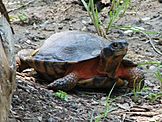Glyptemys facts for kids
Quick facts for kids Glyptemys |
|
|---|---|
 |
|
| Glyptemys muhlenbergii | |
| Scientific classification |
|
| Kingdom: | Animalia |
| Phylum: | Chordata |
| Class: | Reptilia |
| Order: | Testudines |
| Suborder: | Cryptodira |
| Family: | Emydidae |
| Subfamily: | Emydinae |
| Genus: | Glyptemys Agassiz, 1857 |
| Species | |
Glyptemys is a group of turtles that belong to the Emydidae family. This group includes two types of turtles: the bog turtle and the wood turtle. Both of these turtles live only in North America. Before 2001, these turtles were part of a different group called Clemmys. That group now only has one member, the spotted turtle.
When fully grown, these turtles can be between 8.9 and 20 centimeters (3.5 to 7.9 inches) long. They are semiaquatic, which means they spend time both in water and on land. How much time they spend in water can change with the seasons. Their unique body features help tell them apart from other turtles and from each other.
Glyptemys turtles like to live near slow-moving streams and ponds. They eat insects, plants, small creatures without backbones, and even dead animals. These turtles are protected in all the areas where they live.
Contents
Understanding Glyptemys Turtles
| Portion of family Emydidae | ||||||||||||||||||||||||||||||||||||||||||||||||||||||||||||||||||||||||||||||
|
||||||||||||||||||||||||||||||||||||||||||||||||||||||||||||||||||||||||||||||
| Scientists have changed how they group these turtles over time. Now, Clemmys is a group with only one type of turtle. Glyptemys, Terrapene, and Emys are three separate groups. |
The way scientists classify, or group, Emydidae turtles has changed a lot over time. There have been many ideas about how to arrange the different groups and types of turtles.
Before 2001, the bog and wood turtles were part of the Clemmys group. But after scientists studied their bodies and their genes more closely, they found that these two turtles were much more closely related to each other than to the spotted turtle. Because of this, they were moved into a new group called Glyptemys. The spotted turtle is now the only member of the Clemmys group.
The western pond turtle was also once in the Clemmys group. However, it was recently moved to the Actinemys group, where it is now the only member. Both Glyptemys turtles have 50 chromosomes in their cells.
The bog turtle has several common names, like mud turtle, marsh turtle, yellowhead, and snapper. The wood turtle can also be called the sculptured tortoise, red-legged tortoise, or redleg.
What Glyptemys Turtles Look Like
Glyptemys turtles are small to medium-sized. Male bog turtles grow to about 9.4 cm (3.7 inches), and females to about 8.9 cm (3.5 inches). Wood turtles, both male and female, can reach 14 to 20 cm (5.5 to 7.9 inches) in length.
Bog turtles usually weigh around 110 grams (3.9 ounces). Wood turtles weigh about 1 kilogram (2.2 pounds) when they are fully grown. You can recognize a bog turtle by the small, bright patches on each side of its neck. The wood turtle has a dark gray to black head and bright orange colors on its belly and underside.
Where Glyptemys Turtles Live
Glyptemys turtles are native to eastern North America. This means they are found only in this part of the world. Their combined range stretches from Nova Scotia in Canada down to Georgia in the United States. It also goes west from Nova Scotia to Minnesota.
These turtles are semiaquatic. They are often found in wet, spongy areas called bogs and fens, as well as in small streams. They prefer places with soft, yet firm, sandy bottoms.
How They Evolved
During the last ice age, called the Pleistocene period, large sheets of ice pushed Glyptemys turtles south. After the ice melted, some turtle groups moved back to their original northern homes. Others continued to live in the new, southern areas. Scientists have found some old turtle fossils from a period called the Rancholabrean (about 300,000 to 11,000 years ago). These fossils were found in Georgia and Tennessee, which are further south than where these turtles live today.
Daily Life and Behavior
These turtles are diurnal, meaning they are active during the day. They usually start moving around in the early morning. On very cold days, they might spend time underwater. The bog turtle is also known to hide in thick bushes or bury itself in mud to stay warm.
When it gets too hot, these turtles sometimes go into a state called aestivation. This is like a summer sleep, where they become inactive to avoid the heat and dry conditions.
Protecting Glyptemys Turtles
Both the bog turtle and the wood turtle are protected in all the places they live. The bog turtle is considered Critically Endangered. This means it is at a very high risk of disappearing forever. The wood turtle is labeled as Endangered, which is also serious, but slightly less dire than critically endangered.
See also
 In Spanish: Glyptemys para niños
In Spanish: Glyptemys para niños





